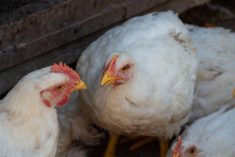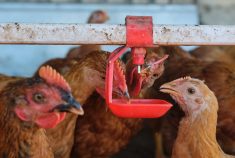A relatively quiet summer for highly pathogenic avian influenza in Canada has turned for the worse, with outbreaks on commercial poultry farms in all four western provinces in the past week alone.
Cases of high-path avian flu in domestic birds in Canada confirmed and reported by the Canadian Food Inspection Agency since Aug. 31 include:
- Aug. 31: Over 9,400 birds on a commercial mixed broiler chicken and turkey operation in Sturgeon County, north of Edmonton;
- Sept. 4: Birds on a commercial poultry farm in Strathcona County, east of Edmonton;
- Sept. 9: Birds on a commercial poultry farm in the R.M. of Laird, north of Saskatoon;
- Sept. 12: Birds on a commercial poultry farm at Chilliwack, B.C.;
- Sept. 12: Birds on a commercial poultry farm in Starland County, north of Drumheller, Alta. (although Alberta’s poultry and egg organizations, in a separate statement Tuesday, described the premises as a “non-commercial” flock);
- Sept. 12: Birds on a commercial poultry farm in the Municipal District of Willow Creek, west of Lethbridge, Alta.;
- Sept. 12: Birds on a commercial poultry farm in the R.M. of Cut Knife, west of North Battleford, Sask.; and
- Sept. 14: Birds on a commercial poultry farm in the R.M. of Cartier, west of Winnipeg. Specifics on the types and numbers of affected birds aren’t yet publicly available on most of the recent cases.
Read Also

Prairie forecast: Plenty more chances for snow over Holidays
The pattern of Pacific storm system after Pacific storm system looks set to continue for a while longer. We begin this forecast period with a heavy snowfall warning in effect across parts of Alberta.
Canada has so far confirmed a total of 120 outbreaks of high-path avian flu in domestic poultry and backyard flocks since December last year. During the entire months of July and August 2022 combined, though, Canada had seen just seven such outbreaks: three in Alberta and four in Quebec.
The Alberta government has already noted the summer slowdown in bird flu cases appears to be over.
“After a lull in the number of cases in June and July, cases are starting to occur again along with the fall wild bird migratory season,” the province said recently on its poultry health website. “As a result, the risk level appears to be rising.”
As of Tuesday, the total number of Canadian domestic birds impacted by avian flu outbreaks since last December has reached 2.363 million across nine provinces, including 1.075 million in Alberta alone, followed by 561,000 in Ontario and 301,000 in Quebec.
Of Canada’s 120 outbreaks, 66 infected premises have been culled, disinfected and released from federal quarantine and 54 premises are still under active movement controls including 18 in Alberta, nine in B.C. and eight each in Ontario and Saskatchewan.
Further south, the U.S. Department of Agriculture’s Animal and Plant Health Inspection Service (APHIS) has confirmed cases in 39 states so far this year, most recently adding Florida on July 22.
As of Wednesday, the number of domestic (commercial and backyard) birds impacted in the U.S. in 2022 now sits at 44.12 million across 445 affected premises, 209 of which are commercial farms. Minnesota alone has reported seven outbreaks on commercial turkey farms since Sept. 7.
Up until the latest wave of high-path avian flu starting last December, Canada had been considered free of notifiable avian flu since 2015.
The risk of avian flu to human health is still considered low and there’ve been no known cases of transmission of H5N1 — the predominant strain in North America’s latest run of high-path outbreaks — from birds to people in North America.
In the rare cases where people do catch avian flu, CFIA has said, it’s most likely to have been transmitted via close human contact with live infected birds, or in “heavily contaminated” environments.
H5N1 is also not known to pose a food safety risk, as poultry and eggs are safe to eat when proper handling and cooking take place.
Whether high- or low-path, H5 and H7 subtypes of the avian influenza virus are federally notifiable diseases in Canada, as both of those H-types are able to mutate from low-path to high-path after they infect domestic birds. — Glacier FarmMedia Network
















